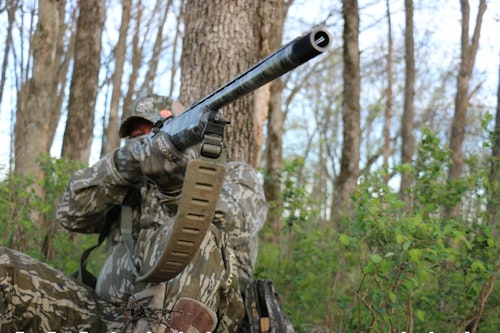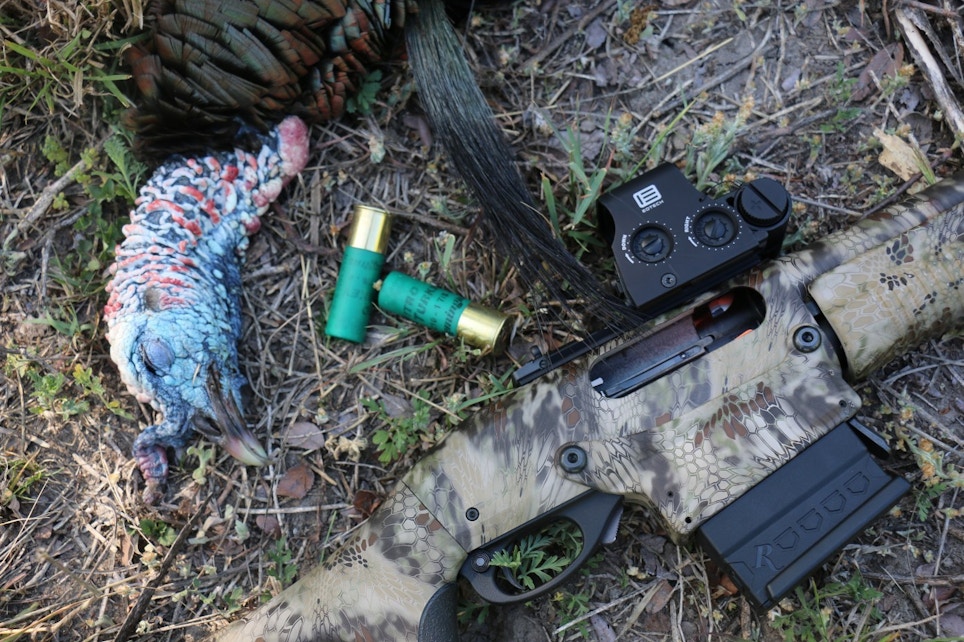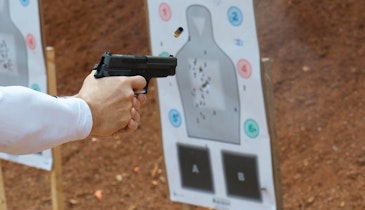Casual hunters who’ve yelped a gobbler to within 25 steps and shot it with a nondescript shotgun might scoff at the concept of a perfectly tailored turkey gun. Don’t tell that to modern turkey specialists.
Today’s gobbler geeks crave specialized shotgun features and aftermarket tweaks that stretch far beyond the realm of typical gun selection. They’ll talk endlessly about choke constrictions, pattern densities, optics performance and other esoteric considerations. But sifting through myriad performance and upgrade options can complicate the turkey-gun selection process, especially for newcomers to the sport.
Fitting customers with personalized turkey shotguns doesn’t have to be difficult. Use these general guidelines to narrow the search and send folks to the spring woods with bona fide gobbler getters.
Gauge
Years ago, 12-gauges dominated the turkey hunting scene. Nowadays, thanks to heavier-than-lead ammo options (see the sidebar), subgauges have become viable turkey killers. With the correct shotshells and chokes, 20s, 28s and even .410s throw fantastic patterns with more than enough downrange energy for clean kills. Choosing a gauge often boils down to the heft of the gun and how much recoil a customer wants to endure.
The 12-gauges remain the top all-around choice, of course, because of their versatility and abundant ammo options. Further, a heavy 12-gauge load will still typically produce the thickest patterns simply because a 12-gauge shell holds more pellets than a subgauge load using the same shot size. The 20s offer lighter weight and reduced recoil, and 28s and .410s really reduce those factors.
The bottom line? Buyers should assess their physical abilities and choose a gauge they will enjoy shooting at the range and in the woods. 28-gauges and .410s are ideal for youngsters, older hunters and even folks with slight builds. 20s can be great for active hunters who tote their shotguns on long cutt-and-run or open-country hunts. Ultimately, a customer must assess what they want to carry and how much felt recoil they’re comfortable handling.
Caveat: With any gauge, customers must match their shotgun with a choke and load that will produce solid patterns at standard turkey-hunting ranges. That’s especially true with the small subgauges. You cannot expect to cleanly kill a gobbler with a light lead 28-gauge or .410 load. Buyers should investigate TSS and other heavier-than-lead options, which produce great downrange energy but use smaller pellets — No. 9s in many cases — to produce thick, consistent patterns.
Action
As with gauge, this boils down to personal preference. Gas-operated semi-auto guns reduce recoil somewhat, and modern models are extremely reliable. Inertia- or recoil-operated repeaters provide unmatched reliability. Tried-and-true pump guns are always a good choice and cost less, though lighter models might increase felt recoil somewhat. Double-guns — typically over-and-unders — offer an interesting option, as customers can use relatively open chokes in one barrel for close birds but a tighter choke in the other tube for longer shots. And single-shots can be perfect for beginning hunters or folks who enjoy the simplicity and challenge of only having one shot. Customers should consider how many shells they’ll want to load afield and the type of action with which they’re proficient. In most cases, turkey hunting is a one-shot game, so the choice might rest on a customer’s hunting style and fondness for a specific action.
Brand
With so many choices available, choosing a shotgun brand can be confusing. Most customers will have a price point in mind and are seeking the best gun for their money. Some will be loyal to specific brands and might pay a bit extra for a gun manufactured by that company. Whatever they’re willing to spend, buyers should always keep quality and reliability in mind. A low price point does little good if a gun requires repairs or is inoperable after a few seasons. Conversely, why pay top dollar for a Cadillac-level gun when a Ford-price-point model will perform just as well? It’s a tricky equation, but always try to guide folks to solid-performing guns that will last them many seasons.
Also, consider whether the customer will use a gun solely for turkeys or also wing-shooting and target shooting. Many companies build turkey-specific guns with shorter barrels and rails or other optics-mounting options. Others offer good all-around models a buyer can use in the spring woods and the duck marsh.
Finish
Turkey guns should have some anti-reflective finish so sharp-eyed gobblers won’t spot flash or glare. The choice often depends on price.
Baked-on camouflage finishes remain the standard for turkey guns, and it’s easy to see why. They eliminate glare, let the gun blend into the landscape and look cool. They also typically increase the gun’s cost somewhat. Lower-cost options, such as black synthetic guns or Parkerizing, also eliminate flash, and guns with those finishes usually cost a bit less. Cerakoting — a light ceramic coating — provides another intriguing option. And in a pinch, customers on a budget can simply purchase a standard blued gun and wrap it in camouflage tape.

Optics
With the advent of ultra-tight chokes and high-performance shotshells, the days of using a simple bead on a turkey gun have passed. Directing a precise shotgun pattern is more akin to shooting a rifle, so turkey hunters rely on high-tech optics.
Customers have many options, from scopes to high-visibility sights, but many favor modern red- or green-dot optics. Price points can vary widely, but a customer’s choice should boil down to quality, longevity and reliability. They’ll want a sight that’s sturdy enough to withstand being dragged through brush and perhaps bumped. Likewise, battery life is critical, as they won’t want to carry spare batteries afield in case of failure. Models with no parallax — that is, the target and reticle are on the same plane — and no or very light magnification are ideal. Further, models that let you adjust brightness pay dividends when hunting from the low light of dawn into bright midday sun.
That’s a lot to consider, but ultimately, try to guide buyers toward models in their price range that will perform for years and have practical features.
Choke
Want to scratch your head? Check out online or social media discussions about points of constriction in shotgun chokes and how many pellets a specific load and choke patterned in a gobbler’s head and neck at 30 steps. The options can be mind-boggling. But don’t just let customers fall into the trap of buying a choke simply labeled “extra-full” or “turkey choke.” They need to at least consider the basics of constriction and find a choke that will put an acceptable number of pellets from a specific shotshell in the turkey hunting kill zone. (The old standard of 100 pellets in a 10-inch circle still applies, but with TSS and precision modern chokes, many shooters get far better performance.)
Popular aftermarket chokes usually have extremely tight constrictions, such as .655 for lead shot in 12-gauges or looser (about .675) for heavier-than-lead 12-gauge loads. Generally, tighter chokes perform best with smaller shot, such as No. 6 lead, and looser models perform better with larger shot, such as No. 4s. Heavier-than-lead shot often requires somewhat looser constrictions. Other factors play a role. A gun’s bore (some 12-gauges have larger bores, such as .745, instead of the standard .729 constriction, for example) can affect choke performance, as it changes the degree of constriction. Further, there are many subtleties involved with matching a specific gun, shell and choke into a high-performance team. Ideally, customers should test several chokes and loads with a gun to see which performs best. They want a combination that shoots thick, tight, consistent patterns at acceptable turkey hunting ranges.
Buyers will also have to choose between ported and non-ported chokes. Ported tubes typically reduce muzzle jump and separate the wad from the shot faster, which can improve patterns. They’re also usually louder.

Aftermarket Upgrades
Slings are a must for turkey hunters, as you’ll tote guns for miles sometimes. Many turkey-specific shotguns come with slings or at least swivels for attaching a sling. In other cases, a simple wrap-around-style sling can suffice. Whatever style they choose, buyers should seek a sling that fits snugly yet comfortably around their shoulder.
Also, customers shooting heavy loads in larger gauges might want reduced recoil, so recoil pads or more expensive recoil-reducing technology can be beneficial.
And for children or newbies, some type of shooting sticks or a bipod can help focus aim and eliminate the need to hold a shotgun steady at the moment of truth.
Conclusion
This season, when customers wander around the shotgun rack with confused looks on their faces, guide them to turkey-specific guns that are durable, perform well and are tailored to their hunting needs and styles. The process might be somewhat tricky, but the final result — a smiling buyer with a gobbler gun that lasts a lifetime — is more than worthwhile.






